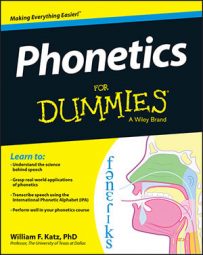You make consonants by completely or partially blocking airflow during speech. You can do this in different ways: you can completely block airflow, push air through a groove or slit to make a hissing sound, block air then make a hiss, or bring the speech articulators (the organs of speech) close together to shape sound. The result is different manners of articulation (different ways of making a sound). You need to be able to label all these processes in order to work with speech in a clinical or educational setting. Here are some key terms for consonant manner of articulation.
Affricate: A stop followed by a fricative with the same place of articulation, such as /ʧ/ as in "chip" and /ʤ/ as in "germ."
Approximant: A sound made by bringing articulators together to shape airflow, while not blocking air or causing hissing. Examples include "read," "weed," "lead," and "you."
Flap: A rapidly made stop consonant, usually voiced, such as the "t" in "Betty" as pronounced in American English
Fricative: A hissy consonant, such as in "fat," "vat," "thick," "this," "sip," "zip," "ship," and "leisure". It's made by producing friction in the airstream.
Glide: A subgroup of the approximants, also called semivowels, including the sounds /j/ as in "you" and /w/ as in "we".
Lateral: Sounds made by directing airflow around the sides of the tongue, such as /l/ in "listen".
Liquid: The other two English approximants (besides glides), /l/ and /ɹ/.
Nasal: Sounds produced with airflow escaping through the nasal passage, such as in "meat," "neat," and "sing".
Stop: Also known as plosive, a sound made with complete closure of the oral cavity.

